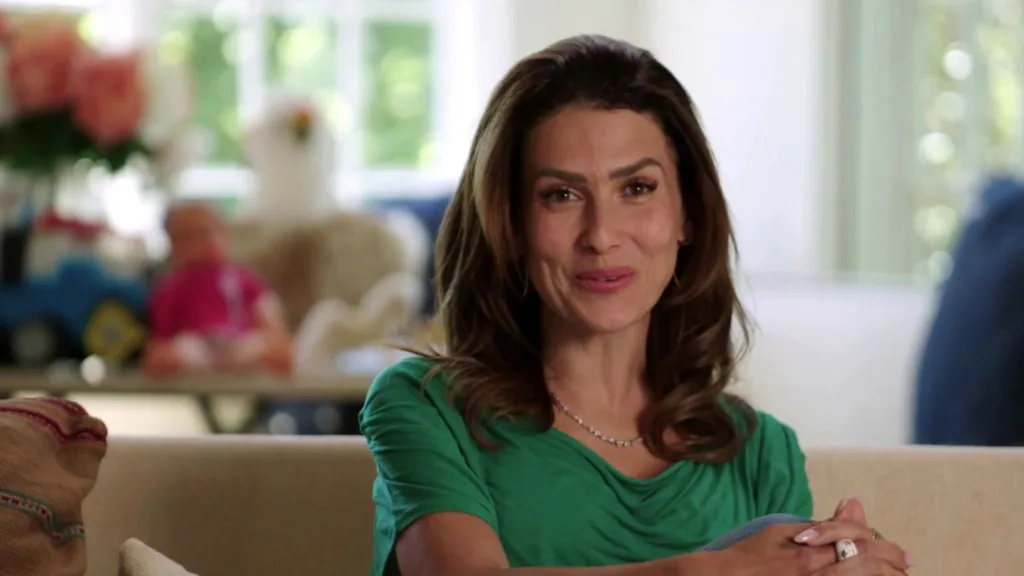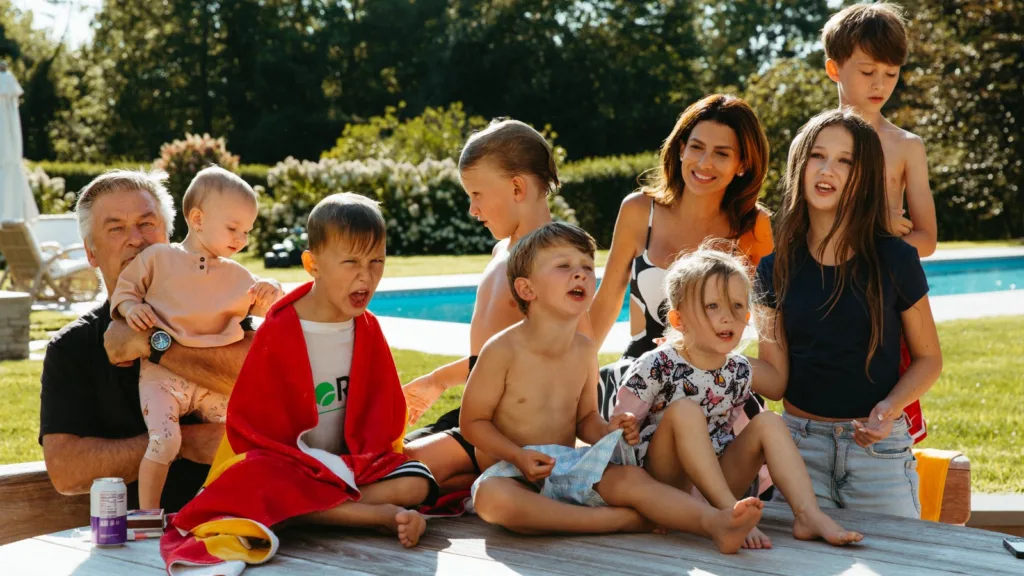A glimpse into “The Baldwins” reveals a television project that spotlights Alec Baldwin, his wife Hilaria, and their sprawling brood of seven. The narrative unfolds in two distinct locales: a compact five-bedroom apartment in Manhattan and a lavish estate in the Hamptons. Set in the summer of 2024 amid a pre-trial atmosphere, the series presents its subjects at a pivotal moment, capturing a family in the midst of significant personal and professional upheaval.
Alec Baldwin, whose storied career has shifted from commanding dramatic roles to embracing the eccentricities of reality television, emerges here as a figure straddling both legacy and transformation.
Hilaria, positioned at the center of a carefully constructed public image, carries the dual responsibilities of parenting and managing the spotlight. Their large family, marked by the challenges and chaos inherent in raising multiple children alongside household pets and staff, serves as both a canvas and a mirror for modern familial existence.
The show employs a format that intermingles moments of domestic disorder with episodes of crisis control. Its production style, characterized by a direct narrative approach and a focus on everyday routines interspersed with significant legal and personal dilemmas, offers viewers a glimpse into a life far removed from the ordinary.
The Domestic Stage
Within the confines of a five-bedroom Manhattan apartment, a vivid portrait of organized disarray unfolds. The limited space forces every movement, every sound, and every burst of laughter from seven children and a host of pets to echo with intensity.
This urban setting stands in sharp contrast to the expansive relief offered by the Hamptons estate, where the luxury of space temporarily softens the relentless pace of family life. The interplay of cramped quarters and open expanses lays bare the dichotomy of a family striving for balance under constant public observation.
Alec and Hilaria exhibit distinct methods of managing their household, a dynamic that emerges with striking clarity in daily interactions. In moments ranging from the chaotic precision of a family haircut to the cacophony of a birthday celebration, the patterns of discipline and care are evident.
Their exchanges, charged with both firmness and tenderness, expose the underlying mechanisms by which order is wrested from the tumult. A particular scene capturing a meticulously planned seating chart for a family drive speaks to a rigor that contrasts sharply with the unplanned bursts of familial spontaneity.
The presence of support staff, though minimal in screen time, hints at the underlying pressures of maintaining a semblance of order. Nannies and aides appear briefly, their contributions a subtle reminder of the complexities inherent in orchestrating a daily routine that doubles as a public narrative. Their fleeting appearances invite a closer look at the delicate balance between raw family interactions and the curated moments intended for the viewer’s gaze.
Every routine chore and celebratory mishap is magnified under the camera’s unyielding eye. The portrayal of everyday tasks transforms common occurrences into a layered narrative of resilience, determination, and the unspoken art of sustaining domestic harmony amid ceaseless activity.
Legal Quicksand and Domestic Equilibrium
The series casts Alec Baldwin into a precarious legal situation, a narrative strand spun from the fatal mishap on the Rust set. Here, the trial’s shadow looms large—a legal inquiry into an accident that reverberates with lasting personal and public ramifications.
The trial forms a backdrop that disrupts any conventional separation between the personal and the performative, placing Baldwin under an unrelenting spotlight where every gesture and word assumes a heightened significance.
In several on-camera moments, Baldwin’s measured expressions betray a strain born of relentless pressure. His pauses before speaking, his guarded tone during interviews, all serve as silent testimonies to a man encumbered by a legal quagmire that has reshaped his public persona. The camera lingers on fleeting instances of vulnerability, capturing the toll of stress and a quiet sense of disquiet that hints at deeper psychological scars.
The series itself takes an unflinching stance on the controversies it portrays. It threads the narrative of legal misadventures and public scrutiny with the everyday realities of family life, incorporating these elements in a manner that neither drowns out the domestic scenes nor obscures the severity of the legal issues.
The portrayal of courtroom anxieties and the emotional weight of unresolved accusations exists alongside scenes of familial routine—children’s laughter, chaotic household activities, and moments of organized confusion.
This interlacing of legal strife and daily family matters challenges the established separation of public scandal from private life. The tension between a high-profile legal predicament and the intimate cadence of family interactions invites viewers to reconsider the boundaries between personal accountability and public rehabilitation.
In this setting, legal battles and familial obligations coalesce into a portrait of a man confronting the consequences of his actions while striving to maintain a semblance of normalcy amid persistent upheaval.
Cultural Constructs and Public Perception
Hilaria’s adoption of a Spanish accent operates as a deliberate performance, a linguistic signal that invites both intrigue and controversy. The series portrays this vocal shift as more than mere affectation—it becomes a visual and auditory motif that sparks dialogue on cultural identity and the often contentious question of cultural representation.
The accent emerges as a tool, fashioned to challenge and recalibrate the narrative around authenticity and self-expression, raising questions about the mutable nature of identity in the public eye.
The program sets itself apart by carefully crafting an image that resists the conventional trappings of celebrity excess. It portrays the Baldwins as inherently relatable, crafting a public persona that appears meticulously managed against a backdrop of relentless media scrutiny. This curated depiction interrogates long-held assumptions about fame, prompting viewers to reassess the interplay between celebrity and normalcy.
Within the microcosm of the Baldwin household, intricate dynamics mirror broader societal discussions. Parenting practices, notable age disparities in the partnership, and nuanced gender roles are depicted in ways that echo contemporary social debates. Each domestic interaction offers a snapshot of evolving familial structures and the shifting expectations imposed on modern families.
Furthermore, the series engages with the art of crisis communication. Through measured, candid dialogues and controlled exposures of personal adversity, the narrative transforms potential scandal into a form of public rehabilitation. The deliberate handling of controversial moments underscores a sophisticated strategy aimed at reshaping public perception without relinquishing the inherent chaos of their lived experience.
Cinematic Cadence and Craft
The series presents a rhythmic flow where quicksilver comedic flashes collide with weighty, measured reflections. Its editing exhibits a nimble interplay between frenetic sequences of household chaos and pauses that evoke introspection. Montage sequences slice through scenes of organized pandemonium, highlighting fleeting moments of levity alongside scenes laden with the gravity of legal and personal quandaries.
Direct-to-camera interviews serve as a window into the core of its protagonists. The confessionals extract a candidness from Alec and Hilaria, capturing snippets of thought with a directness that feels both unvarnished and meticulously curated.
These segments strip away artifice, revealing insights into the personalities behind the public veneer, their expressions conveying unspoken tensions and the strain of living under constant scrutiny.
The visual palette of the series is defined by its deliberate choice of camera angles that oscillate between tight, intimate frames of domestic life and expansive shots that reveal the stark contrast between urban confinement and suburban liberty.
A musical score punctuates these images, with arrangements reminiscent of big-band jazz energizing scenes of disorder, while quieter, more somber compositions underscore reflective interludes. This aural layer crafts an atmosphere that is simultaneously kinetic and contemplative, enhancing the overall texture of the narrative.
Transitions between the multifaceted narrative threads are executed with an artful precision. The editing does not allow any element—be it legal proceedings, domestic uproar, or cultural commentaries—to dominate. Instead, it orchestrates a careful shifting of focus that sustains viewer engagement while maintaining a coherent sense of progression throughout the series.
Reflections in a Fractured Mirror
The series artfully interlaces gravity with levity, presenting a dynamic interplay where sorrow and laughter coalesce in unexpected harmony. Scenes of family celebrations carry an undercurrent of latent distress—a symbolic dance between the inevitability of misfortune and the buoyancy of humor. In these moments, the celebratory act of gathering, of sharing a meal or cutting a cake, transforms into an emblem of the human spirit’s refusal to yield entirely to despair.
At its core, the narrative wrestles with themes of personal identity and the relentless pursuit of rehabilitation. The ongoing struggle to reclaim dignity amid public scandal emerges as a powerful motif, one that exposes the raw fissures between a crafted public image and the reality of internal conflict. Here, every smile and every measured confession serves as a subtle commentary on the pressures of maintaining a persona under unyielding scrutiny.
The family is rendered not merely as a collection of individuals but as a cohesive unit symbolizing fortitude in turbulent times. Their interactions—ranging from spontaneous bursts of chaos to meticulously planned routines—function as a microcosm of modern familial roles, illustrating both vulnerability and enduring strength.
The juxtaposition of intimate moments with the spectacle of public life critiques the essence of celebrity culture. This portrayal challenges the expectation of glamour in the public sphere, drawing attention instead to the multifaceted realities behind familiar faces.
Recurring visual and narrative motifs punctuate the series, imbuing everyday occurrences with metaphorical significance. Chaotic household scenes mirror the inner landscapes of anxiety and resilience, while carefully staged sequences of order offer fleeting glimpses of solace. Such imagery compels a reexamination of the relationship between personal truth and its public manifestation.
The Review
The Baldwins
The Baldwins presents a riveting exploration of celebrity culture, blending familial chaos with the weight of public scandal. The series challenges conventional portrayals of fame, offering a vivid study of identity and resilience amid unyielding media scrutiny. Its bold narrative and striking visual language create a compelling, if occasionally uneven, viewing experience.
PROS
- Bold narrative with striking visual style
- Intricate portrayal of family dynamics
- Rich cultural commentary on identity and celebrity
- Thought-provoking blend of humor and gravity
- Engaging exploration of public image and resilience
CONS
- Uneven pacing at times
- Occasional lack of narrative cohesion
- Over-curated moments detracting from raw spontaneity
- Heavy focus on scandal that may overshadow familial nuances



















































